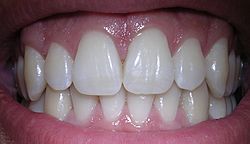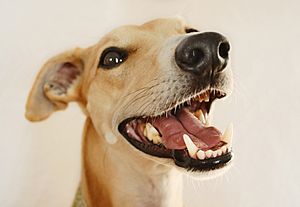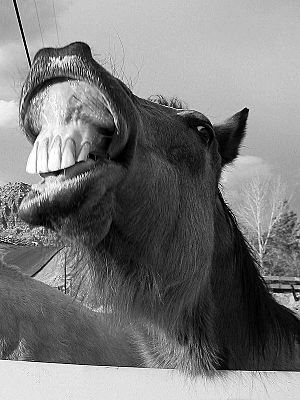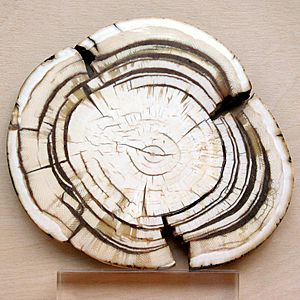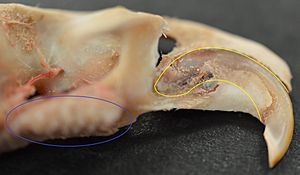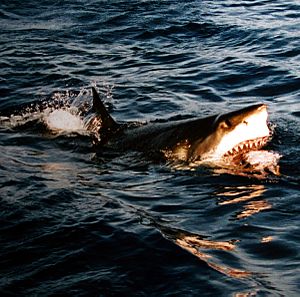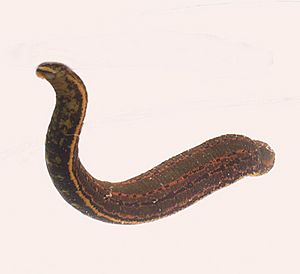Tooth facts for kids
A tooth is one of the hard, white things in your mouth. Teeth (plural) are used to help the mastication process by chewing food. Chew means to break up and crush food so it can be swallowed (pushed down into your stomach).
Most vertebrates and many other animals have teeth. Different animals have different kinds because they eat different foods. Some animals use teeth as a weapon. Human adults usually have 32 teeth. Human children usually have 20 teeth.
Contents
Tooth eruption
Deciduous teeth or milk teeth or temporary teeth are the first set of teeth for most mammals. Humans have 20 of them. The first teeth (called "primary teeth") start to erupt (come through the skin of the jaw) when a baby is about 6 months old. When these teeth erupt it can hurt. Babies chew on things to make the pain better. This is called teething (verb: to teethe). Most children have all 20 teeth by two or three years of age.
At age 6–7 the permanent teeth start to erupt. By the age of 11–12 most children have 28 adult teeth. The last four teeth, called 'wisdom teeth' or third molars come in by age 17–21 in most people. Some people never grow wisdom teeth. Or they may have only two instead of four.
Tooth structure
The outside white part of teeth is called the enamel. The enamel is made of calcium phosphate and is very hard. Under the enamel is the dentine. The dentine is softer than the hard enamel. So it is hurt more by tooth decay (cavities.) Under the dentine is the pulp which has the nerves and blood vessels that go to the tooth. This is the part that causes the pain of a toothache. Cementum is outside the dentine where there is no enamel. Cementum holds the tooth to the bone of the jaw.
Types of teeth
Healthy teeth
If they are protected and kept clean, teeth should stay for a person's whole life. Many people lose their teeth early because they do not do the right things to keep teeth healthy.
Some things people can do to keep teeth healthy:
- Brush teeth after every meal and at bedtime with a soft-bristled brush.
- Floss after every meal (but at least once a day at bedtime). Flossing should be done before brushing!
- Drink water with fluoride before brushing. Or, use a fluoride mouthrinse (but not for children under age 6).
- See a dentist every 6 months for a tooth exam and tooth cleaning.
- Eat good foods.
- Sugars like sucrose and glucose are bad for teeth.
- Milk and cheese are good for teeth because they have calcium.
- Unsweetened (no sugar) chewing gum helps clean teeth, and makes salvia and removes food particles.
- Nothing with flavor in-between meals, give your saliva the two to three hours it needs to clean teeth. The saliva can not do that if there is a continuous food film being put on to the teeth.
- Dehydration leads to less saliva production. Drink plenty of water every day.
Disease of teeth
Plaque is the soft white substance that forms on teeth when they are not cleaned. It has bacteria in it that hurt enamel. If plaque is not cleaned off, after 2 days it can become tartar. Tartar is a hard substance that forms on teeth (mostly near the gums). Tartar makes gums unhealthy and makes more bacteria grow on the teeth.
Plaque is cleaned off with a toothbrush. If tartar forms on teeth, a dentist must clean it off.
The bacteria that are on teeth eat into the enamel. Cleaning teeth, flossing teeth, eating good foods, and having a dentist take off plaque make less bacteria on teeth. If there is too much bacteria, they eat enamel faster than teeth make enamel. This makes holes in enamel called cavities. When a person gets cavities, he has the disease dental caries. Making cavities in enamel happens slowly. But once cavities go through enamel, the soft dentin is hurt much faster. If the cavity is not fixed by a dentist, it can go into the root. This permanently hurts the tooth. Once this happens the tooth must be taken out or the dentist must do a root canal (a surgery to replace the root with a chemical substance to keep the tooth in place, at times dangerous.) If the tooth is not fixed with a root canal or is not taken out, a tooth infection can happen. This infection can spread onto the face. It can even kill the person if not helped by a dentist or doctor.
Origin
The genes governing tooth development in mammals are homologous to those involved in the development of fish scales. Study of a tooth plate of a fossil of the extinct fish Romundina stellina showed that the teeth and scales were made of the same tissues, also found in mammal teeth, lending support to the theory that teeth evolved as a modification of scales.
Mammals
Teeth are among the most distinctive (and long-lasting) features of mammal species. Paleontologists use teeth to identify fossil species and determine their relationships. The shape of the animal's teeth are related to its diet. For example, plant matter is hard to digest, so herbivores have many molars for chewing and grinding. Carnivores, on the other hand, have canine teeth to kill prey and to tear meat.
Mammals, in general, are diphyodont, meaning that they develop two sets of teeth. In humans, the first set (the "baby," "milk," "primary" or "deciduous" set) normally starts to appear at about six months of age, although some babies are born with one or more visible teeth, known as neonatal teeth. Normal tooth eruption at about six months is known as teething and can be painful. Kangaroos, elephants, and manatees are unusual among mammals because they are polyphyodonts.
Aardvark
In Aardvarks, teeth lack enamel and have many pulp tubules, hence the name of the order Tubulidentata.
Canines
In dogs, the teeth are less likely than humans to form dental cavities because of the very high pH of dog saliva, which prevents enamel from demineralizing. Sometimes called cuspids, these teeth are shaped like points (cusps) and are used for tearing and grasping food
Cetaceans
Like human teeth, whale teeth have polyp-like protrusions located on the root surface of the tooth. These polyps are made of cementum in both species, but in human teeth, the protrusions are located on the outside of the root, while in whales the nodule is located on the inside of the pulp chamber. While the roots of human teeth are made of cementum on the outer surface, whales have cementum on the entire surface of the tooth with a very small layer of enamel at the tip. This small enamel layer is only seen in older whales where the cementum has been worn away to show the underlying enamel.
The toothed whale is a suborder of the cetaceans characterized by having teeth. The teeth differ considerably among the species. They may be numerous, with some dolphins bearing over 100 teeth in their jaws. On the other hand, the narwhals have a giant unicorn-like tusk, which is a tooth containing millions of sensory pathways and used for sensing during feeding, navigation, and mating. It is the most neurologically complex tooth known. Beaked whales are almost toothless, with only bizarre teeth found in males. These teeth may be used for feeding but also for demonstrating aggression and showmanship.
Primates

In humans (and most other primates) there are usually 20 primary ("baby") teeth, 28 to 32 of what's known as permanent teeth, in addition to other four being third molars or wisdom teeth, each of which may or may not grow in.
Among primary teeth, 10 of them are usually found in the maxilla (i.e. upper jaw) and the other 10 in the mandible (i.e. lower jaw). Among permanent teeth, 16 are found in the maxilla and the other 16 in the mandible. Most of the teeth have uniquely distinguishing features.
Horse
An adult horse has between 36 and 44 teeth. The enamel and dentin layers of horse teeth are intertwined. All horses have 12 premolars, 12 molars, and 12 incisors. Generally, all male equines also have four canine teeth (called tushes) between the molars and incisors. However, few female horses (less than 28%) have canines, and those that do usually have only one or two, which many times are only partially erupted. A few horses have one to four wolf teeth, which are vestigial premolars, with most of those having only one or two. They are equally common in male and female horses and much more likely to be on the upper jaw. If present these can cause problems as they can interfere with the horse's bit contact. Therefore, wolf teeth are commonly removed.
Horse teeth can be used to estimate the animal's age. Between birth and five years, age can be closely estimated by observing the eruption pattern on milk teeth and then permanent teeth. By age five, all permanent teeth have usually erupted. The horse is then said to have a "full" mouth. After the age of five, age can only be conjectured by studying the wear patterns on the incisors, shape, the angle at which the incisors meet, and other factors. The wear of teeth may also be affected by diet, natural abnormalities, and cribbing. Two horses of the same age may have different wear patterns.
A horse's incisors, premolars, and molars, once fully developed, continue to erupt as the grinding surface is worn down through chewing. A young adult horse will have teeth which are 4.5-5 inches long, with the majority of the crown remaining below the gumline in the dental socket. The rest of the tooth will slowly emerge from the jaw, erupting about 1/8" each year, as the horse ages. When the animal reaches old age, the crowns of the teeth are very short and the teeth are often lost altogether. Very old horses, if lacking molars, may need to have their fodder ground up and soaked in water to create a soft mush for them to eat in order to obtain adequate nutrition.
Proboscideans
Elephants' tusks are specialized incisors for digging food up and fighting. Some elephant teeth are similar to those in manatees, and it is notable that elephants are believed to have undergone an aquatic phase in their evolution.
At birth, elephants have a total of 28 molar plate-like grinding teeth not including the tusks. These are organized into four sets of seven successively larger teeth which the elephant will slowly wear through during its lifetime of chewing rough plant material. Only four teeth are used for chewing at a given time, and as each tooth wears out, another tooth moves forward to take its place in a process similar to a conveyor belt. The last and largest of these teeth usually becomes exposed when the animal is around 40 years of age, and will often last for an additional 20 years. When the last of these teeth has fallen out, regardless of the elephant's age, the animal will no longer be able to chew food and will die of starvation.
Rabbit
Rabbits and other lagomorphs usually shed their deciduous teeth before (or very shortly after) their birth, and are usually born with their permanent teeth. The teeth of rabbits complement their diet, which consists of a wide range of vegetation. Since many of the foods are abrasive enough to cause attrition, rabbit teeth grow continuously throughout life. Rabbits have a total of 6 incisors, three upper premolars, three upper molars, two lower premolars, and two lower molars on each side. There are no canines. Three to four millimeters of the tooth is worn away by incisors every week, whereas the posterior teeth require a month to wear away the same amount.
The incisors and cheek teeth of rabbits are called aradicular hypsodont teeth. This is sometimes referred to as an elodent dentition. These teeth grow or erupt continuously. The growth or eruption is held in balance by dental abrasion from chewing a diet high in fiber.
Rodents
Rodents have upper and lower hypselodont incisors that can continuously grow enamel throughout its life without having properly formed roots. These teeth are also known as aradicular teeth, and unlike humans whose ameloblasts die after tooth development, rodents continually produce enamel, they must wear down their teeth by gnawing on various materials. Enamel and dentin are produced by the enamel organ, and growth is dependent on the presence of stem cells, cellular amplification, and cellular maturation structures in the odontogenic region. Rodent incisors are used for cutting wood, biting through the skin of fruit, or for defense. This allows for the rate of wear and tooth growth to be at equilibrium. The microstructure of rodent incisor enamel has shown to be useful in studying the phylogeny and systematics of rodents because of its independent evolution from the other dental traits. The enamel on rodent incisors are composed of two layers: the inner portio interna (PI) with Hunter-Schreger bands (HSB) and an outer portio externa (PE) with radial enamel (RE). It usually involves the differential regulation of the epithelial stem cell niche in the tooth of two rodent species, such as guinea pigs.
The teeth have enamel on the outside and exposed dentin on the inside, so they self-sharpen during gnawing. On the other hand, continually growing molars are found in some rodent species, such as the sibling vole and the guinea pig. There is variation in the dentition of the rodents, but generally, rodents lack canines and premolars, and have a space between their incisors and molars, called the diastema region.
Manatee
Manatees are polyphyodont with mandibular molars developing separately from the jaw and are encased in a bony shell separated by soft tissue.
Walrus
Walrus tusks are canine teeth that grow continuously throughout life.
Fish
Fish, such as sharks, may go through many teeth in their lifetime. The replacement of multiple teeth is known as polyphyodontia.
A class of prehistoric shark are called cladodonts for their strange forked teeth.
Amphibians
All amphibians have pedicellate teeth which are modified to be flexible due to connective tissue and uncalcified dentine that separates the crown from the base of the tooth.
Most amphibians exhibit teeth that have a slight attachment to the jaw or acrodont teeth. Acrodont teeth exhibit limited connection to the dentary and have little enervation. This is ideal for organisms who mostly use their teeth for grasping, but not for crushing and allows for rapid regeneration of teeth at a low energy cost. Teeth are usually lost in the course of feeding if the prey is struggling. Additionally, amphibians that undergo a metamorphosis develop bicuspid shaped teeth.
Reptiles
The teeth of reptiles are replaced constantly during their life. Juvenile crocodilians replace teeth with larger ones at a rate as high as one new tooth per socket every month. Once adult, tooth replacement rates can slow to two years and even longer. Overall, crocodilians may use 3,000 teeth from birth to death. New teeth are created within old teeth.
Birds
A skull of Ichthyornis discovered in 2014 suggests that the beak of birds may have evolved from teeth to allow chicks to escape their shells earlier, and thus avoid predators and also to penetrate protective covers such as hard earth to access underlying food.
Invertebrates
True teeth are unique to vertebrates, although many invertebrates have analogous structures often referred to as teeth. The organisms with the simplest genome bearing such tooth-like structures are perhaps the parasitic worms of the family Ancylostomatidae. For example, the hookworm Necator americanus has two dorsal and two ventral cutting plates or teeth around the anterior margin of the buccal capsule. It also has a pair of subdorsal and a pair of subventral teeth located close to the rear.
Historically the European medicinal leech, another invertebrate parasite, has been used in medicine to remove blood from patients. They have three jaws (tripartite) that look like little saws, and on them are about 100 sharp teeth used to incise the host. The incision leaves a mark that is an inverted Y inside of a circle. After piercing the skin and injecting anticoagulants (hirudin) and anaesthetics, they suck out blood, consuming up to ten times their body weight in a single meal.
In some species of Bryozoa, the first part of the stomach forms a muscular gizzard lined with chitinous teeth that crush armoured prey such as diatoms. Wave-like peristaltic contractions then move the food through the stomach for digestion.
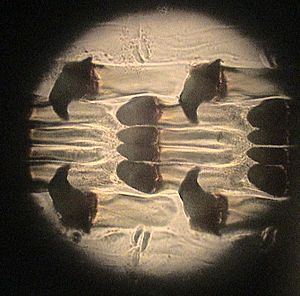
Molluscs have a structure called a radula which bears a ribbon of chitinous teeth. However, these teeth are histologically and developmentally different from vertebrate teeth and are unlikely to be homologous. For example, vertebrate teeth develop from a neural crest mesenchyme-derived dental papilla, and the neural crest is specific to vertebrates, as are tissues such as enamel.
The radula is used by molluscs for feeding and is sometimes compared rather inaccurately to a tongue. It is a minutely toothed, chitinous ribbon, typically used for scraping or cutting food before the food enters the oesophagus. The radula is unique to molluscs, and is found in every class of mollusc apart from bivalves.
Within the gastropods, the radula is used in feeding by both herbivorous and carnivorous snails and slugs. The arrangement of teeth (also known as denticles) on the radula ribbon varies considerably from one group to another as shown in the diagram on the left.
Predatory marine snails such as the Naticidae use the radula plus an acidic secretion to bore through the shell of other molluscs. Other predatory marine snails, such as the Conidae, use a specialized radula tooth as a poisoned harpoon. Predatory pulmonate land slugs, such as the ghost slug, use elongated razor-sharp teeth on the radula to seize and devour earthworms. Predatory cephalopods, such as squid, use the radula for cutting prey.
Related pages
See also
 In Spanish: Diente para niños
In Spanish: Diente para niños


